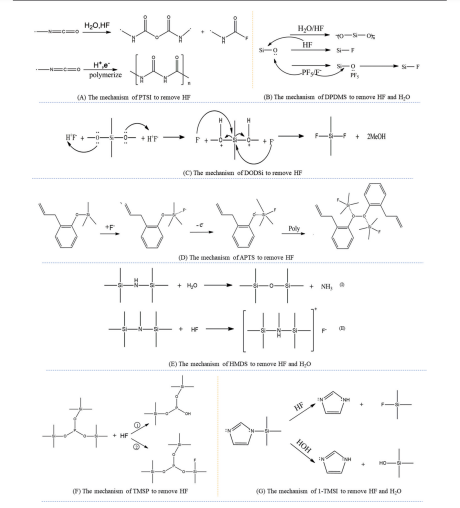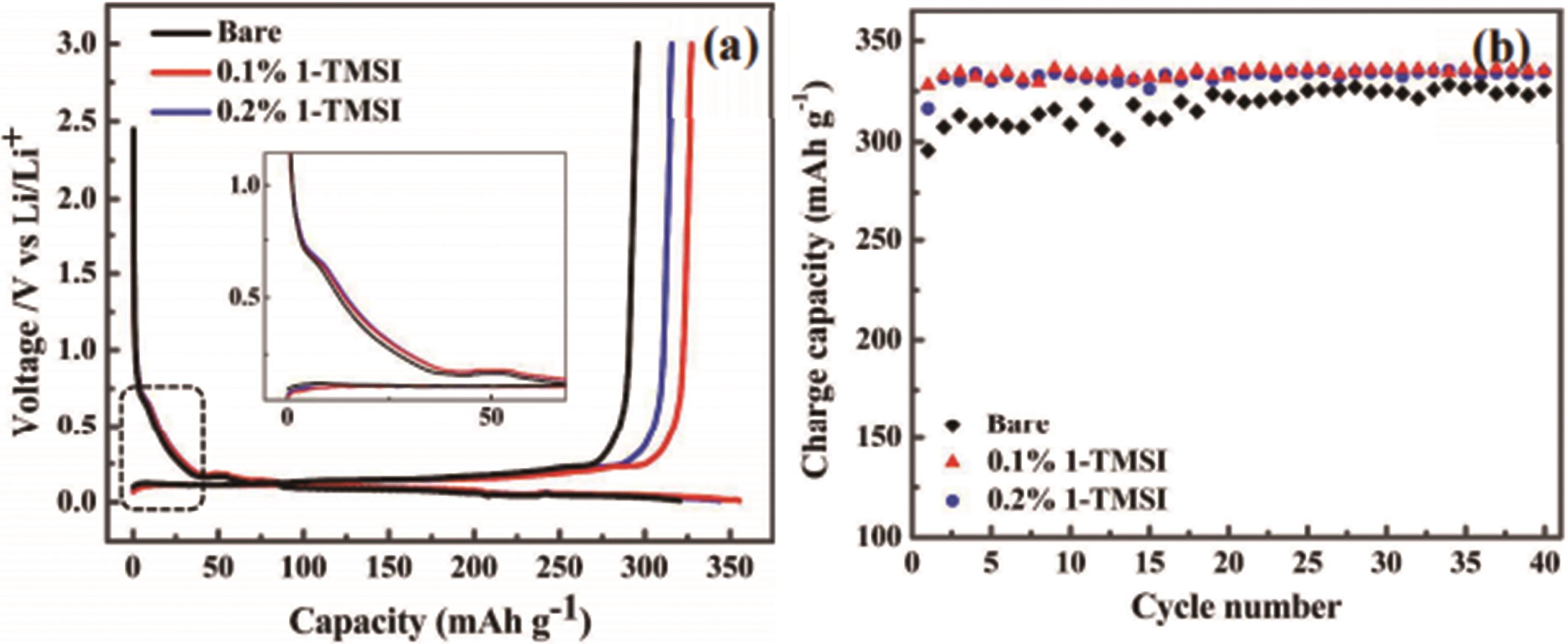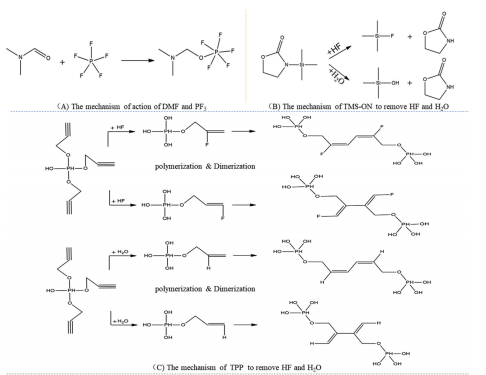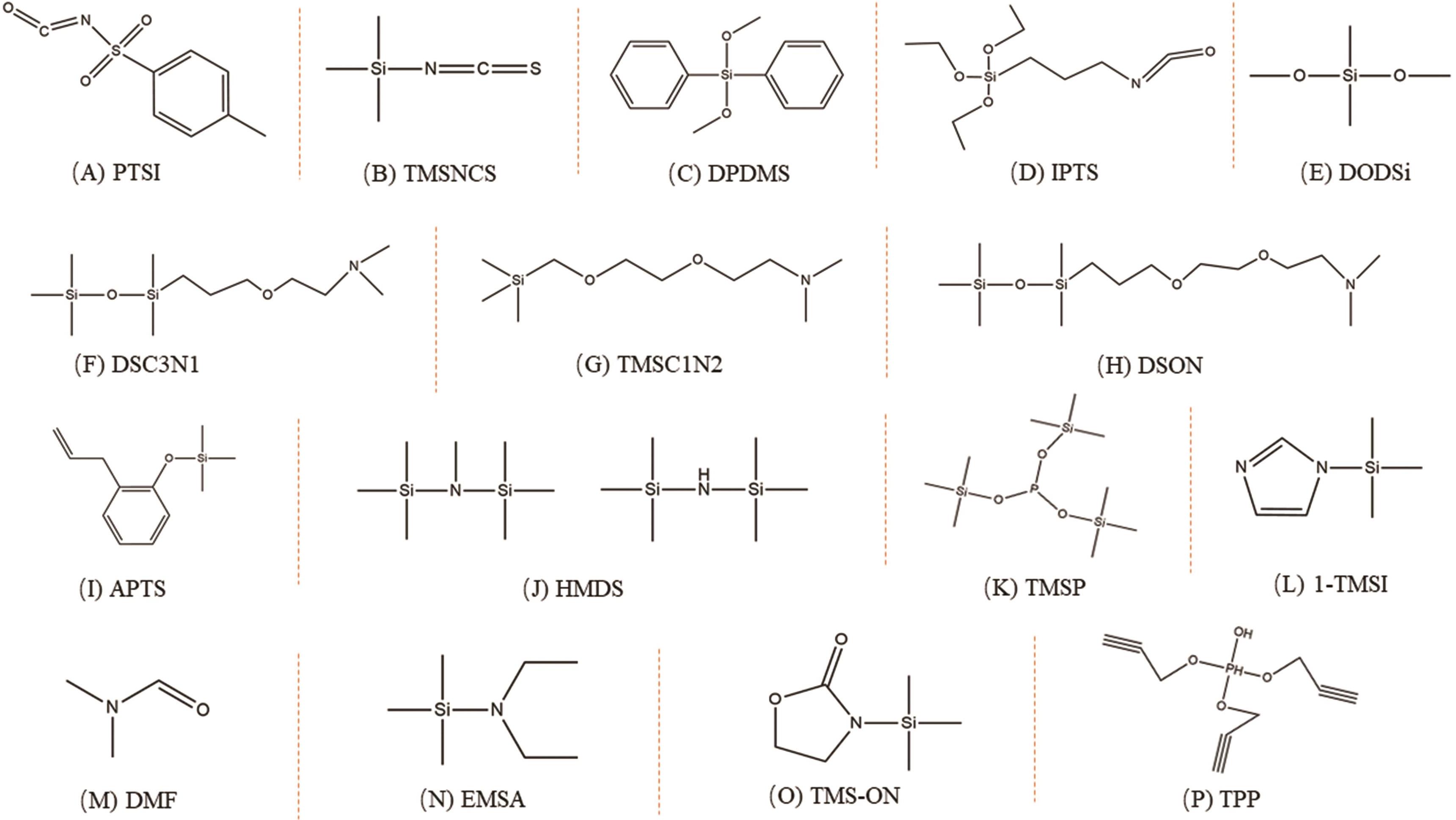
Chinese Journal of Applied Chemistry ›› 2022, Vol. 39 ›› Issue (5): 697-706.DOI: 10.19894/j.issn.1000-0518.210129
• Review • Next Articles
Research Progress of Additives for Acid and Water Removal in Electrolyte of Lithium Ion Battery
Lin-Hu SONG1,2, Shi-You LI1,2,3( ), Jie WANG1,2, Jing-Jing ZHANG1,2, Ning-Shuang ZHANG1,2,3, Dong-Ni ZHAO1,2,3, Fei XU1,2
), Jie WANG1,2, Jing-Jing ZHANG1,2, Ning-Shuang ZHANG1,2,3, Dong-Ni ZHAO1,2,3, Fei XU1,2
- 1.School of Petrochemical Technology,Lanzhou University of Technology,Lanzhou 730050,China
2.Gansu Key Laboratory of Low-Carbon Energy and Chemical Engineering,Lanzhou 730050,China
3.Gansu Engineering Laboratory of Electrolyte Material for Lithium-ion Battery,Lanzhou 730050,China
-
Received:2021-03-19Accepted:2021-08-24Published:2022-05-01Online:2022-05-24 -
Contact:Shi-You LI -
About author:lishiyoulw@163.com
-
Supported by:the National Natural Science Foundation of China(21766017)
CLC Number:
Cite this article
Lin-Hu SONG, Shi-You LI, Jie WANG, Jing-Jing ZHANG, Ning-Shuang ZHANG, Dong-Ni ZHAO, Fei XU. Research Progress of Additives for Acid and Water Removal in Electrolyte of Lithium Ion Battery[J]. Chinese Journal of Applied Chemistry, 2022, 39(5): 697-706.
share this article
Add to citation manager EndNote|Ris|BibTeX
URL: http://yyhx.ciac.jl.cn/EN/10.19894/j.issn.1000-0518.210129

Fig.2 The action mechanisms of various additives to remove HF and H2O: (A) Mechanism of PTSI to remove HF[8], (B) Mechanism of DPDMS to remove HF and H2O[9], (C) Mechanism of DODSi to remove HF[11], (D) Mechanism of APTS to remove HF[12], (E) Mechanism of HMDS to remove HF and H2O[25,28], (F) Mechanism of TMSP to remove HF[33], and (G) Mechanism of 1-TMSI to remove HF and H2O[34]

Fig.3 (a) Initial charge/discharge capacities, and (b) Charge capacity retention of Li/MCMB cells that are tested in the electrolytes without and with 1-TMSI additive[34]

Fig.4 Mechanism of new additives to remove HF and H2O: (A) Mechanism of action of DMF and PF5[13],(B) Mechanism of TMS?ON to remove HF and H2O[15], (C) Mechanism of TPP to remove HF and H2O[16]
添加剂 Additive | 特点 Characteristics | 不足 Insufficiencies |
|---|---|---|
异氰酸酯(—N Isocyanate (—N | —N The N atoms in —N | 该化合物作为添加剂在电解液中除杂的研究较少,机理仍需进一步探究 There's not a lot of research on using these compounds as additives to remove impurities in the electrolyte, and the mechanism still needs to be further explored |
硅烷类(Si—O)化合物 Silane (Si—O) compounds | Si—O烷基属于碱类化合物,可与H+结合,除去电解液中酸性杂质,并且Si对F较高的亲和力可清除分离出的F-,同时参与SEI膜的构建 Si—O alkyl can be combined with H+ to remove acidic impurities in electrolyte, due to its basic functional groups, and the separated F can be removed by Si with higher affinity to F-,participating in the construction of SEI film | Si—O与杂质反应生产络合物参与SEI膜的构建机理目前还不明确,仍需进一步研究 The mechanism of Si—O reacting with impurities to produce complexes and participating in the construction of SEI film is still unclear, and further research is needed |
新型化合物添加剂 Other new compound additives | 在极端环境下(如高温高压),亲F-或亲H+型添加剂自身可清除电解液中的HF杂质 The additives can remove HF impurities in the electrolyte by their affinity with F- or H+ under extreme environments (such as high temperature and high potential) | 高温高压条件易导致电解液分解产生其它杂质,故在该环境下研究除酸、除水型添加剂较为困难 Electrolyte is easy to decompose to produce other impurities at high temperature and potential, so it is difficult to study acid and water removing additives under this condition |
Table 1 Characteristics of various acid?removing and water?removing additives
添加剂 Additive | 特点 Characteristics | 不足 Insufficiencies |
|---|---|---|
异氰酸酯(—N Isocyanate (—N | —N The N atoms in —N | 该化合物作为添加剂在电解液中除杂的研究较少,机理仍需进一步探究 There's not a lot of research on using these compounds as additives to remove impurities in the electrolyte, and the mechanism still needs to be further explored |
硅烷类(Si—O)化合物 Silane (Si—O) compounds | Si—O烷基属于碱类化合物,可与H+结合,除去电解液中酸性杂质,并且Si对F较高的亲和力可清除分离出的F-,同时参与SEI膜的构建 Si—O alkyl can be combined with H+ to remove acidic impurities in electrolyte, due to its basic functional groups, and the separated F can be removed by Si with higher affinity to F-,participating in the construction of SEI film | Si—O与杂质反应生产络合物参与SEI膜的构建机理目前还不明确,仍需进一步研究 The mechanism of Si—O reacting with impurities to produce complexes and participating in the construction of SEI film is still unclear, and further research is needed |
新型化合物添加剂 Other new compound additives | 在极端环境下(如高温高压),亲F-或亲H+型添加剂自身可清除电解液中的HF杂质 The additives can remove HF impurities in the electrolyte by their affinity with F- or H+ under extreme environments (such as high temperature and high potential) | 高温高压条件易导致电解液分解产生其它杂质,故在该环境下研究除酸、除水型添加剂较为困难 Electrolyte is easy to decompose to produce other impurities at high temperature and potential, so it is difficult to study acid and water removing additives under this condition |
| 1 | AURBACH D, MARKOVSKY B, SALITRA G, et al. Review on electrode-electrolyte solution interactions, related to cathode materials for Li-ion batteries[J]. J Power Sources, 2007, 165(2): 491-499. |
| 2 | BING J, HWANG, CHIEN Y, et al. Structure, morphology, and electrochemical investigation of LiMn2O4 thin film cathodes deposited by radio frequency sputtering for lithium microbatteries[J]. J Phys Chem C, 2009, 113(26): 11373-11380. |
| 3 | LI W T, CAMPION C, LUCHT B L, et al. Additives for stabilizing LiPF6-based electrolytes against thermal decomposition[J]. J Electrochem Soc, 2005, 152(7): A1361-A1365. |
| 4 | XU G J, LIU Z H, ZHANG C J, et al. Strategies for improving the cyclability and thermo-stability of LiMn2O4-based batteries at elevated temperatures[J]. J Mater Chem A, 2015, 3(8): 4092-4123. |
| 5 | 王洁, 崔孝玲, 赵冬妮, 等. 适配于富锂锰基正极材料电解液体系的研究[J]. 现代化工, 2020, 40(1): 19-24. |
| WANG J, CUI X L, ZHAO D N, et al. Study on electrolyte adapted to lithium-rich layered oxide cathode materials[J]. Mod Chem Ind, 2020, 40(1): 19-24. | |
| 6 | 徐菲, 李世友, 赵冬妮, 等. 硅烷添加剂在锂离子电池电解液中的应用[J]. 硅酸盐学报, 2021, 49(1): 161-166. |
| XU F, LI S Y, ZHAO D N, et al. Application of silane additive in electrolyte of lithium ion battery[J]. J Chinese Ceram Soc, 2021, 49(1): 161-166. | |
| 7 | ZHANG S S. Aromatic isocyanate as a new type of electrolyte additive for the improved performance of Li-ion batteries[J]. J Power Sources, 2006, 163(1): 567-572. |
| 8 | DONG P, WANG D, YAO Y, et al. Stabilizing interface layer of LiNi0.5Co0.2Mn0.3O2 cathode materials under high voltage using p-toluenesulfonyl isocyanate as film forming additive[J]. J Power Sources, 2017, 344: 111-118. |
| 9 | DENG B W, WANG H, GE W J, et al. Investigating the influence of high temperatures on the cycling stability of a LiNi0.6Co0.2Mn0.2O2 cathode using an innovative electrolyte additive[J]. Electrochim Acta, 2017, 236: 61-71. |
| 10 | WANG S L, CHEN S M, GAO W Q, et al. A new additive 3-isocyanatopropyltriethoxysilane to improve electrochemical performance of Li/NCM622 half-cell at high voltage[J]. J Power Sources, 2019, 423: 90-97. |
| 11 | JANG S H, YIM T. Effect of silyl ether-functinoalized dimethoxydimethylsilane on electrochemical performance of a Ni-rich NCM cathode[J]. ChemPhysChem, 2017, 18(23): 3402-3406. |
| 12 | YE C C, TU W Q, YIN L M, et al. Converting detrimental HF in electrolyte into a highly-fluorinated interphase on cathode[J]. J Mater Chem A, 2018, 6(36): 17642-17652. |
| 13 | YOU L, DUAN K, ZHANG G, et al. N,N-Dimethylformamide electrolyte additive via a blocking strategy enables high performance lithium ion battery under high temperature[J]. J Phys Chem C, 2019, 123: 5942-5950. |
| 14 | 陈家辉. 锂离子电池高电压电解液制备及其作用机理研究[D]. 深圳: 深圳大学, 2016. |
| CHEN J H. Preparation and investigation of high voltage electrolyte for lithium-ion battery[D]. Shenzhen: Shenzhen University, 2016. | |
| 15 | KIM K, HWANG D, KIM S, et al. Cyclic aminosilane-based additive ensuring stable electrode-electrolyte interfaces in Li-ion batteries[J]. Adv Energy Mater, 2020, 10(15): 2000012. |
| 16 | ZHAO W M, ZHENG B Z, LI H D, et al. Toward a durable solid electrolyte film on the electrodes for Li-ion batteries with high performance[J]. Nano Energy, 2019, 63: 103815. |
| 17 | JOW R T, ZHANG S, XU K, et al. Non-aqueous electrolyte solutions comprising additives and non-aqueous electrolyte cells comprising the same: US, US6905762 B1[P]. 2005. |
| 18 | HAN J G, JEONG M Y, KIM K, et al. An electrolyte additive capable of scavenging HF and PF5 enables fast charging of lithium-ion batteries in LiPF6-based electrolytes[J]. J Power Sources, 2020, 446: 227366. |
| 19 | AMINE K, WANG Q, VISSERS, et al. Novel silane compounds as electrolyte solvents for Li-ion batteries[J]. Electrochem Commun, 2006, 8(3): 429-433. |
| 20 | WANG J, ZHAO X, LUO H, et al. A novel aminoalkyldisiloxane compound as a film-forming electrolyte additive for graphite anode[J]. Electrochemistry, 2015, 83(7): 537-540. |
| 21 | WANG J L, HAO L, MAI Y J, et al. Synthesis of aminoalkylsilanes with oligo(ethylene oxide) unit as multifunctional electrolyte additives for lithium-ion batteries[J]. Sci China Chem, 2013, 56: 739-745. |
| 22 | WANG S Q, WANG J L, HAO L, et al. A novel aminoalkylsilane compound with oligo(ethylene oxide) units as effective additive for improving cyclability of lithium-ion batteries[J]. J Mater Sci Technol, 2013, 29: 53-57. |
| 23 | ZHANG L, LYONS L, NEWHOUSE J, et al. Synthesis and characterization of alkylsilane ethers with oligo(ethylene oxide) substituents for safe electrolytes in lithium-ion batteries[J]. J Mater Chem, 2010, 20(38): 8224-8226. |
| 24 | YAN X D, CHEN C, ZHU X Q, et al. Aminoalkyldisiloxane as effective electrolyte additive for improving high temperature cycle life of nickel-rich LiNi0.6Co0.2Mn0.2O2/graphite batteries[J]. J Power Sources, 2020, 461: 228099. |
| 25 | YAMANE H, INOUE T, FUJITA M, et al. A causal study of the capacity fading of Li1.01Mn1.99O4 cathode at 80 ℃, and the suppressing substances of its fading[J]. J Power Sources, 2001, 99(1): 60-65. |
| 26 | LI Y K, ZHANG R X, LIU J S, et al. Effect of heptamethyldisilazane as an additive on the stability performance of LiMn2O4 cathode for lithium-ion battery[J]. J Power Sources, 2009, 189(1): 685-688. |
| 27 | WU X W, GUO H J, LI X H, et al. Effect of heptamethyldisilazane on the electrochemical performance of LiMn2O4/Li[J]. Ionics, 2013, 19(3): 429-435. |
| 28 | WU X W, LI X H, WANG Z X, et al. Improvement on the storage performance of LiMn2O4 with the mixed additives of ethanolamine and heptamethyldisilazane[J]. Appl Surf Sci, 2013, 268: 349-354. |
| 29 | LI Y K, ZHANG R X, LIU J S, et al. Effect of heptamethyldisilazane as an additive on the stability performance of LiMn2O4 cathode for lithium-ion battery[J]. J Power Sources, 2009, 189(1): 685-688. |
| 30 | SAIDI Y M, GAO F, BARKER J, et al. Additive to stabilize electrochemical cell: US, US5846673 A[P]. 1998. |
| 31 | TAKECHI K, KOIWAI A, SHIGA T. Nonaqueous electrolytic solution for battery and nonaqueous electrolytic solution battery: US, US6077628 A[P]. 2000. |
| 32 | ZHANG S S. A review on electrolyte additives for lithium-ion batteries[J]. J Power Sources, 2006, 162(2): 1379-1394. |
| 33 | JUNG G H, SUNG J L, JAEGI L, et al. Tunable and robust phosphite-derived surface film to protect lithium-rich cathodes in lithium-ion batteries[J]. ACS Appl Mater Interfaces, 2015, 7(15): 8319-8329. |
| 34 | WOTANGO A S, SU W N, LEGGESSE E G, et al. Improved interfacial properties of MCMB electrode by 1-(trimethylsilyl)imidazole as new electrolyte additive to suppress LiPF6 decomposition[J]. ACS Appl Mater Interfaces, 2017, 9(3): 2410-2420. |
| [1] | Fang-Zheng HU, Xing GAO, Lei LIU, Tian-Heng YUAN, Ning CAO, Kai LI, Ya-Tao WANG, Jian-Hua LI, Hui-Qin LIAN, Xiao-Dong WANG, Xiu-Guo CUI. Advances in Black Phosphorus Anode Advantages and Optimization in Li-ion Battery Anodes [J]. Chinese Journal of Applied Chemistry, 2023, 40(4): 571-582. |
| [2] | Lu-Fei WANG, Meng-Meng ZHEN, Bo-Xiong SHEN. Research Progress of Controlling Lithium-Sulfur Batteries by Electrocatalysts under Lean Electrolyte Conditions [J]. Chinese Journal of Applied Chemistry, 2023, 40(2): 188-209. |
| [3] | Xue-Jian SHI, Wan-Qiang LIU, Chun-Li WANG, Yong CHENG, Li-Min WANG. Research Progress of Sb-based Anode Materials for Potassium Ion Batteries [J]. Chinese Journal of Applied Chemistry, 2023, 40(2): 210-228. |
| [4] | Xin GU, Wen-Qing WANG, Jun-He HOU, Lu GAO, Ming-Hua HUANG, Ge SU. Advances of Inorganic‑inorganic Composite Electrochromic Films [J]. Chinese Journal of Applied Chemistry, 2022, 39(9): 1345-1359. |
| [5] | Jing ZHOU, Yu-Xuan CHEN, Jun-Ming MA, Xiao-Fei ZHU, De-Feng ZHOU. Effect of MgO and Fe2O3 Incorporation on the Microstructure and Electrochemical Performance of GDCSi System [J]. Chinese Journal of Applied Chemistry, 2022, 39(5): 809-818. |
| [6] | Qi ZHANG, Qian ZHANG, Xiao-Meng SHI, Ya-Qi KONG, Ke-Xin GAO, Ya-Ping DU. Research Progress of Rare Earth Bromides Based Solid Electrolytes for All⁃Solid⁃State Batteries [J]. Chinese Journal of Applied Chemistry, 2022, 39(4): 585-598. |
| [7] | Yu-Le WANG, Ke-Li YANG, Yan-Fang GAO. Preparation and Electrochemical Properties of Molybdenum Carbide Modified Silica [J]. Chinese Journal of Applied Chemistry, 2022, 39(11): 1716-1725. |
| [8] | Ying ZHAO, Yi-Jia SHAO, Luo-Qian LI, Jian-Wei REN, Shi-Jun LIAO. Research Progress on the Degradation Mechanism and Cycle Stability Improvement of Lithium-Rich Cathode Materials [J]. Chinese Journal of Applied Chemistry, 2022, 39(02): 205-222. |
| [9] | WANG Xu-Yao, FANG Ying-Jun, ZHANG Ling-Zhi. Synthesis and Characterization of Cross-linked Solid Polymer Electrolyte Based on N-Cyanoethylated Polyethylenimine for Lithium-Ion Batteries [J]. Chinese Journal of Applied Chemistry, 2021, 38(8): 946-953. |
| [10] | ZHANG Xiaobo, XIN Haiying, XU Shuang, ZHANG Xinghai, WANG Liqiu. Cellulose Gel Polymer Electrolytes and Its Application in Supercapacitors [J]. Chinese Journal of Applied Chemistry, 2020, 37(5): 547-554. |
| [11] | ZHANG Xiaobo, XIN Haiying, XU Shuang, ZHANG Xinghai, WANG Liqiu. Cellulose Gel Polymer Electrolytes and Its Application in Supercapacitors [J]. Chinese Journal of Applied Chemistry, 2020, 37(5): 0-. |
| [12] | HU Chen,JIN Yi,ZHU Shaoqing,XU Ye,SHUI Jianglan. Methods for Improving Low-Temperature Performance of Lithium Iron Phosphate Based Li-Ion Battery [J]. Chinese Journal of Applied Chemistry, 2020, 37(4): 380-386. |
| [13] | LIU Lixin, DONG Jianhong, ZHANG Guanghui, ZHU Luyi, WANG Xinqiang, XU Dong, CHOW Yuktak. Preparation and Properties of Polyvinylidene Fluoride@Diatomite Fiber Membranes by Eletrospinning as Separator of Lithium-Ion Batteries [J]. Chinese Journal of Applied Chemistry, 2020, 37(12): 1441-1446. |
| [14] | SHENG Lei,LI Tingyu,GUO Lifang,LI Gang,ZHANG Wendong. Application of Functionalized Multi-walled Carbon Nanotubes Filled Gel Electrolyte in Dye-Sensitized Solar Cells [J]. Chinese Journal of Applied Chemistry, 2019, 36(7): 815-822. |
| [15] | ZUO Zicheng,LI Yuliang. Applications of Graphdiyne in Li+/Na+ Battery Anodes [J]. Chinese Journal of Applied Chemistry, 2018, 35(9): 1057-1066. |
| Viewed | ||||||
|
Full text |
|
|||||
|
Abstract |
|
|||||

 C
C O)基化合物
O)基化合物 C
C O)-based compounds
O)-based compounds C
C O中的N原子与H原子结合形成络合物,不仅清除了副产物HF和PF5,还参与生成优良的界面膜
O中的N原子与H原子结合形成络合物,不仅清除了副产物HF和PF5,还参与生成优良的界面膜 C
C O combine with H atoms to form complexes, which not only remove the by-products HF and PF5, but also participate in the formation of the excellent interfacial film
O combine with H atoms to form complexes, which not only remove the by-products HF and PF5, but also participate in the formation of the excellent interfacial film